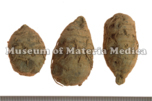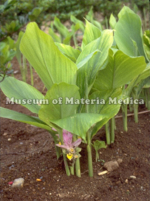Curcuma Rhizome

|
Market name:文朮 Photo location:Museum of Materia Medica, Inst. of Nat. Med. TMPW No.:4588 |

|
Plant name:Curcuma zedoaria Photo location:Kagoshima Pref., Japan Photo date:1995 Photographer:K. Komatsu |
| Synonym | |
| Latin name | Curcumae Rhizoma |
| Botanical source: Family name | Zingibereceae |
| Botanical source: Plant name | Curcuma zedoaria Roscoe (IPNI:872393-1) |
| Part used | Rhizome |
| Empirical criteria for quality selection | Good one is large, fat and fresh. The inside is dense (NI). |
| Constituents | Monoterpenoids: 1,8-Cineole, 1,4-Cineole, α-Pinene, d-Camphene d-Camphor, d-Borneol Sesquiterpenoids: Zingiberene, Furanodiene, Curdione, Isofuranogermacrene, Isocurzerene, Dehydrocurdione, Curzerenone, Zederone, Curcolone, Curcumol, Curcumenol, Procurcumenol, Curcumadiol, Germacrone, Furanogermenone, (4S,5S)-(+)-Germacrone 4,5-epoxide, Zedoarol, 13-Hydroxygermacrone, Curzeone, Curcumenone |
| Pharmacological effects | Vasorelaxing and anti-inflammatory effect |
| Indications | As an aromatic stomachic, stimulant, carminative, painkiller and for inducing menstruation, it is applied to treat indigestion, gripe, menopause and other dysfunction. |
| Diseases | Intra-abdominal tumor, Amenorrhea, Menorrhalgia, Hyperemesis after childbirth, Swelling and pain due to contusion, Abdominal pain, Full stomach, Nausea, Vomitting, Cancer |
| Formulas | jofuto |
| Meridian tropism | Liver, Spleen |
| Property | Warm |
| Flavor | Bitter, Acrid/pungent |
| Classification in "Shen-non Ben-cao Jing" | |
| TCM: Classification | Drugs for invigorating blood circulationt |
| TCM: Medicinal effects | To promote the flow of qi and eliminate blood stasis, distention and pain due to stagnation of undigested food. Used for mass in the abdomen, amenorrhea due to blood stasis, distention and pain due to stagnation of undigested food, and carcinoma of cervix at early stage. |
| Remarks | Listed in the Japanese Pharmacopoeia 18th ed. In China, the underground part of genus Curcuma is divided into rhizome and tuber. They are named differently. The rhizome of C.phaeocaulis Val. is called Pengezhu (Ezhu, Wenzhu) and its tuber is called Lusiyujin. The rhizome of C.kwangsiensis S. G. Lee et C. F. Liang is called the following: the whole rhizome is called Wenezhu, the one which is cut longitudinally is called Pianjianghuang and the tuber is called Wenyujin. Their respective production areas are Sichuan Prov., Guangxi Prov. Zhuangzu Autonomous Region and Zhejiang Prov. The Pharmacopoeia of the People's Republic of China lists these three rhizoma as Ehzu. In Japan, They are cultivated in Kagoshima, Okinawa and other prefectures. Most of them are used as an ingredient for domestic medicine. The nomenclature is C. zedoaria Roscoe according to The Japanese Pharmacopoeia. Nomenclatures of Ehzu are complicated. In China, C. zedoaria Roscoe, C. caesia Roxburgh and C. aeruginosa Roxburgh have been applied as nomenclatures of Ehzu. But they were renamed as C. phaeocaulis Val. in 1989, since it became clear that they were not appropriately named in terms of the color of the rhizome and the flower bud. In Japan, Chinese ehzu is commonly used as a crude drug. Therefore, the quality depends on the original plant. |
| References | NI: N. Isshiki, Methods of Quality Evaluation and Preparation of Wakan-yak, Tohodo Shoten, Tokyo, 1987. |
DNA sequences of medicinal plants
| Gene Region | |||||||||||||||||||
| Nuclear | Chloroplast | Mitochondria | |||||||||||||||||
| Botanical source: Plant name | 5Ss | 18S | ITS1 | 5.8S | ITS2 | 26S | others | trnH-psbA | matK | trnK | trnK-rps16 | trnT-L | trnL | trnL-F | rbcL | rpoC1 | ndhF | others | |
|
|
|||||||||||||||||||
|
|
|||||||||||||||||||
|
|
|||||||||||||||||||
